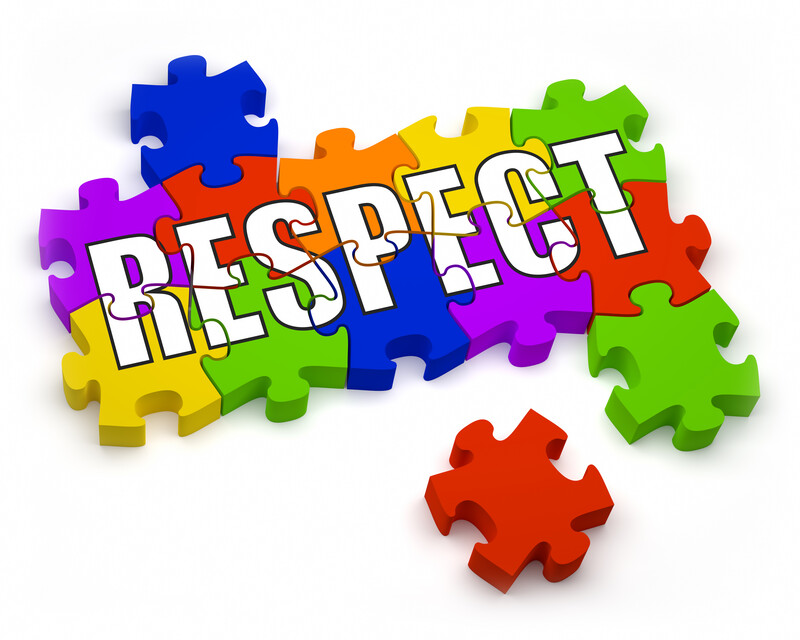
RESPECTFUL Communication Guidelines
People of different backgrounds and personalities bring with them different communications styles. Building a more respectful and inclusive organization, especially in meetings, can be fostered by using RESPECTFUL Communication Guidelines at the beginning of every meeting. When used consistently, they help groups communicate more effectively and, over time, help build a culture of respect.
RESPECTFUL Communication Guidelines are ground rules that help diverse groups communicate more effectively. Diversity comes in many forms. We tend to think that diversity includes categories such as race, ethnicity, gender, sexual identity, and national origin. People also differ by education, geography, military experience, privilege, tenure, marital status and many others. We also differ by deep-seated, often unconscious differences such as attitudes toward leadership, conflict, time, and who is invited to speak and who is not.
RESPECTFUL Communication Guidelines are like the traffic rules one has to understand before getting a license to drive. We take a test to prove we know and will follow the rules to lessen the possibility of traffic accidents. With interpersonal communication, we do not pass a test, but we need to be reminded how to interact respectfully. Otherwise, we may react to others who are different or have a different point of view with negative attitudes, put-downs, verbal abuse, harsh judgments and dismissal.
The goal in using RESPECTFUL Communication Guidelines is to build a safe, respectful, and effective organization instead of one riven by toxicity and broken relationships.
 Written in an acronym, RESPECT, the guidelines are easy to remember.
Written in an acronym, RESPECT, the guidelines are easy to remember.
R = take RESPONSIBILITY for what you say and feel without blaming others.
E = use EMPATHETIC listening.
S = be SENSITIVE to differences in communication styles.
P = PONDER what you hear and feel before you speak.
E = EXAMINE your own assumptions and perceptions.
C = Share CONSTRUCTIVE information for the purpose of upholding the well-being of the community.
T – TRUST that greater truth comes through diversity.
Here are more detailed explanations for each guideline.
R” stands for taking “Responsibility for what you say and feel without blaming others.”
We use “I” statements, such as “I think,” “I feel,” “I noticed,” “I wonder,” or “I believe” for two reasons. First, we claim our experience and respect our ideas, thoughts and feelings. Second, when we use “I” statements, we are less likely to judge or blame others for what we are feeling. For example, when someone says something that I disagree with, if I am not taking responsibility for what I feel, I might say something like, “You’re wrong!” A more responsible way to express my views would be, “I have a different perspective on this issue, and this is why.” Some people might say, “It doesn’t matter how I say it as long as I say what is on my mind!” But in English, sentences beginning with “you” often feel judgmental. When a person feels judged, they become defensive and stop listening.
“E” stands for “use Empathetic listening.” Listen not just to words; listen to the whole person. Try to feel and see the world as the person who is speaking sees and feels it. Of course, this is an almost-impossible task because no matter how empathetic I am to someone, I am not that person. I did not have the same upbringing and experiences. Such limitations make it reasonable to ask questions when we do not understand. This means we need to be patient with each other—and, sometimes, we may need to explain something in a different way so that others can understand more fully.
“S” stands for “be Sensitive to differences in communication styles.” Sensitivity to different communication styles is essential to effective, inclusive communication. For example, when someone is silent in a meeting, it could mean that the person agrees with what is being said. Silence could also mean that the person disagrees, is tired, does not care, is thinking, is confused or is waiting to be invited to speak due to personal style or cultural training. One behavior has many possible interpretations of its meaning. Remember, people communicate in different styles; therefore, do not simply interpret another’s behavior from your own assumptions. Ask questions for clarification.
“P” stands for “Ponder what you think and feel before you speak.” Consider what we are going to say before we say it. When we attend to our insides, we communicate greater authenticity.
The second “E” stands for “Examine your own assumptions and perceptions.” We ask ourselves, “What caused me to think or feel a certain way now? Are there personal experiences that I need to explore further before I speak?” This is another way to take responsibility for what we feel.
“C” = Share CONSTRUCTIVE information for the purpose of upholding the well-being of the community. Engage in constructive dialogue and feedback, offering insights, suggestions, and critiques in a manner that promotes growth, learning, and collaboration. Maintain honesty and authenticity in all communications, avoiding misinformation, exaggeration, or damaging practices that could undermine the community’s trust. Criticism should be offered constructively, with a focus on ideas rather than individuals.
“T” stands for “Trust that greater truth comes through diversity.” In diverse organizations and communities, there will be different experiences, understanding and opinions. Different cultural groups may approach work in ways markedly different yet are totally appropriate to each group’s culture and customs. These multiple approaches need to be tolerated so that together greater truth can be uncovered.
When and How to Use RESPECTFUL Communication Guidelines
When groups are new to the RESPECTFUL Communication Guidelines, provide a full explanation of the Guidelines. Two things need to happen for them to be effective:
First, ask participants if they have any clarifying questions on the Guidelines. Most of the time, it involves clarifying the meaning of a particular word or giving a concrete example that will increase one’s understanding of a suggested approach to communication.
Secondly, ask participants to give a sign of agreement to uphold these Guidelines for the time they have together by their raising hands, saying yes or signing a handout of the document.
Many will not understand the full impact of the Guidelines until they experience their usefulness during a conflicted meeting. Then the Guidelines become a safety net on which the group can rely when someone in the group communicates in a
disrespectful manner. At this time, the facilitator can remind the group to follow the Guidelines by reviewing them again.
When first introducing the Guidelines, take a substantial amount of time to present the full explanation as outlined above. In subsequent meetings, the shorter version that follows can be utilized.
To get more engagement, invite another member of the group to read the Guidelines. Another variation is to have each participant read one guideline until all the guidelines have been read.
What to Do When Someone Disagrees
Ask for more clarification. For example, ask: “What part of the guidelines do you not agree or have trouble with?” This way, you will get more information to work with in terms of what specifically the participant was thinking.
Contact Mark Smutny at Civic Reinventions, Inc.
For more ideas and resources, visit my website at https://civicreinventions.com. Email me at mark.smutny@civicreinventions.com or call me at 626-676-0287.
Dr. Mark Smutny is a nonprofit consultant specializing in conflict resolution, strategic planning and DEI immersion workshops. He teaches, writes, and consults on transforming unproductive conflict into mission success. He is the award-winning author of Thrive: The Facilitator’s Guide to Radically Inclusive Meetings, 2nd Edition.
© 2024 Mark Smutny and Civic Reinventions, Inc.
